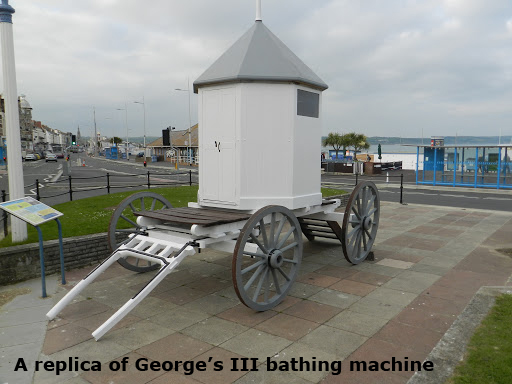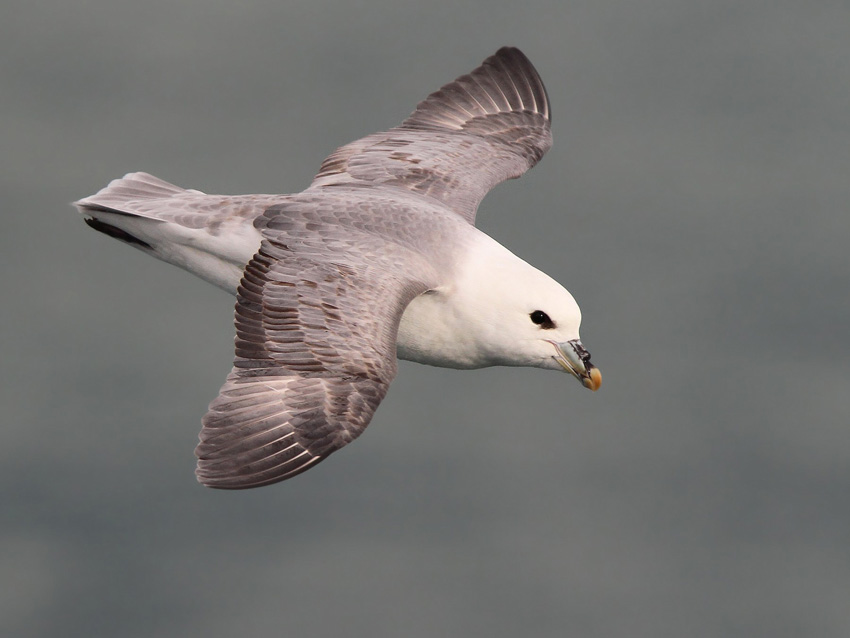




Back to the Dorset Page

- The Royal Connection
- Dorset Eats
- Owlbut's Birdwatch
- Dorset VIPs
In November 1788 George III, King of
Great Britain, had a mental breakdown. Plans were made for his son, also called George and later George IV, to rule in his place as Prince Regent. However
by March 1789 George III had made an amazing recovery. One of the King's many doctors, a Doctor Crane, was one of several people who at that time felt that
bathing in the sea was a cure for many illnesses. One of George's younger brothers, the Duke of Gloucester, had a house in Weymouth in Dorset and offered
to lend it to his brother for a seaside visit.
 King George III first dipped his toe in the sea
at Weymouth on the 7th of July 1789. He made use of a bathing machine just like the one in the picture.
The King would climb into the machine and undress while the machine was drawn by horses into the sea Then he would emerge and helped by a group of lady
bathing attendants would duck his head under the water. Apparently a band hidden in a neighbouring machine struck up God Save the King as he ducked his
head under.
King George III first dipped his toe in the sea
at Weymouth on the 7th of July 1789. He made use of a bathing machine just like the one in the picture.
The King would climb into the machine and undress while the machine was drawn by horses into the sea Then he would emerge and helped by a group of lady
bathing attendants would duck his head under the water. Apparently a band hidden in a neighbouring machine struck up God Save the King as he ducked his
head under.
The visit was a great success. The Queen stating that the King was much better and stronger for sea bathing although, it is said, she had no
interest in doing it herself. The King and his entourage returned to Weymouth in 1791 and every year until 1805, excluding 1793 and 1803. While he was
there his government came to visit him and it was in Weymouth in 1796 that George signed the papers making Admiral Nelson a Lord. The King's routine at
Weymouth was usually the same. An early morning bathe followed by a bit of riding, sailing or walking. He also used to talk to the locals, particularly
farmers, which earned him the nickname "Farmer George."
Although George III left Weymouth for the last time in 1805 there are still two monuments to the King in the area. The first is a statue of
George III, showing him in his coronation robes, on the sea front. It was unveiled in 1810. Since 1949 it has been painted in heraldic colours and is
situated just above the replica bathing machine. The second monument is the Osmington white horse. This is a carving of George on horseback in the
hillside overlooking Weymouth Bay. It was reports of the King's visits which made Weymouth a popular seaside resort and also increased the popularity of
sea bathing.

Dorset has adopted the Apple Cake
as being typical food of the county and who am I to disagree. However everyone, excluding me, has their own version and so it was difficult to decide
which one to use. Even Mary Berry has one.
Basically it is just a cake with apples and brown sugar. It would appear that the apples, and you can choose
any variety, can be in the cake, on top the cake, both on top and in the cake; it's entirely up to you! Although called a cake it also makes a great pudding,
served with custard, cream or even ice cream.
We made ours with the apples inside and it was really good.
![]() Back to the top
Back to the top
The Fulmar is related to the albatross and is an almost gull-like seabird. It is always offshore except when breeding. The
fulmar can be seen flying low over the sea with stiff wings. Fulmars are at their breeding sites nearly all year, although young birds leave in late summer. At
its breeding sites it will fly high up the cliff face, riding the updraughts. They defend their nests from intruders by spitting out a foul-smelling oil.
They eat fish waste, crustaceans (shell fish) and sand eels. They will feed in flocks out at sea. There are about 500,000 pairs in the UK but over
1½ million birds breeding here. Their feathers are grey and white and their legs are grey. Their beak is black and yellow, of medium length and thickness and
hooked.
Fulmars are between 45 and 50 cms in length, have a wingspan of just over 1 metre and can weigh between 610 and 1,000 grams.

Seven random people who were born in Dorset in the last 100 years:-
Serena Scott Thomas (Actor), Zara Dampney (Beach Volleyball Player), Alan Carr (Comedian), P J Harvey (Singer), Virginia Wade (Tennis Player ‐
Wimbledon Champion), Alex James (musician ‐ Bassist With Blur) and Annie Dalton (Children's Author).
![]() Back to the top
Back to the top

